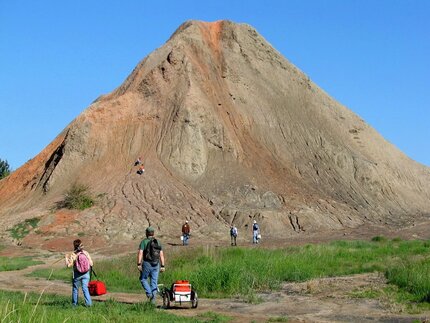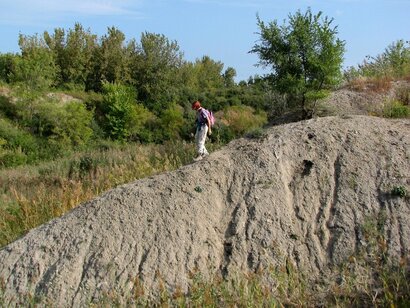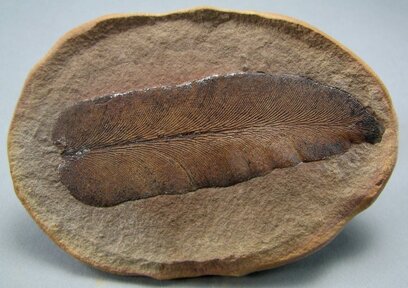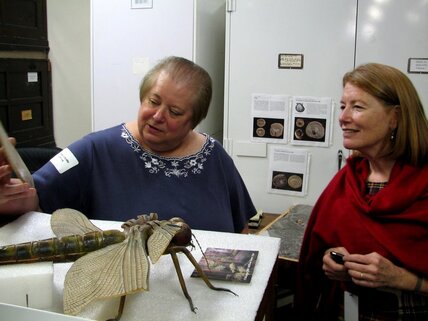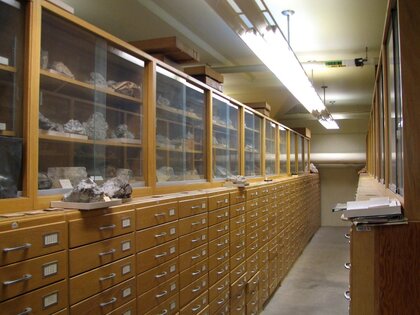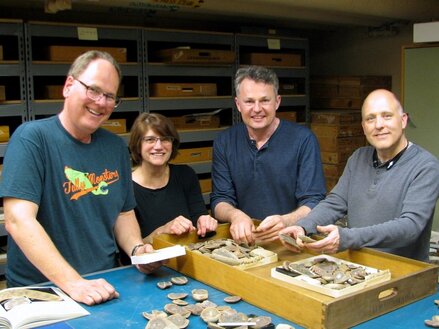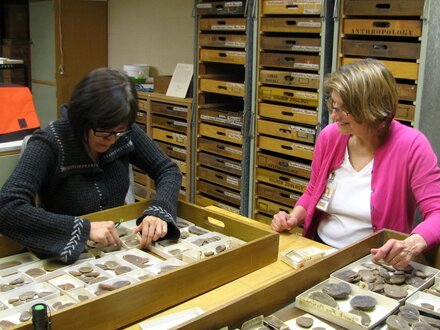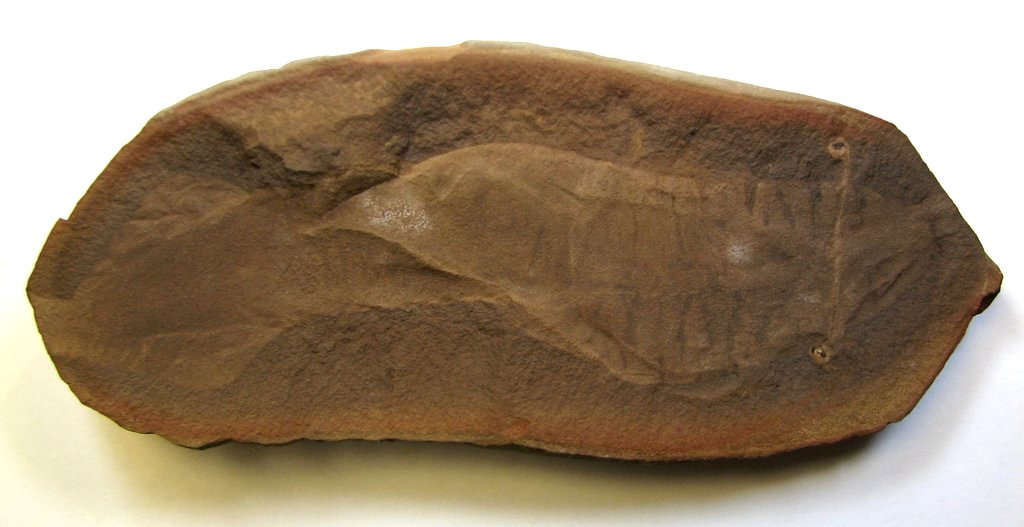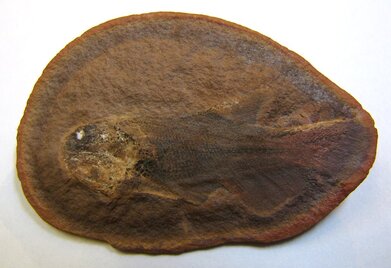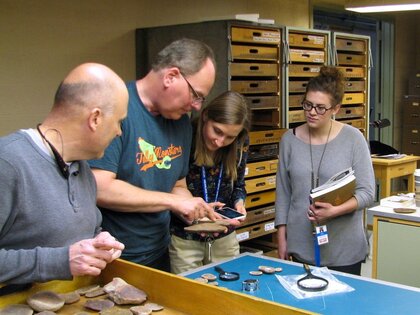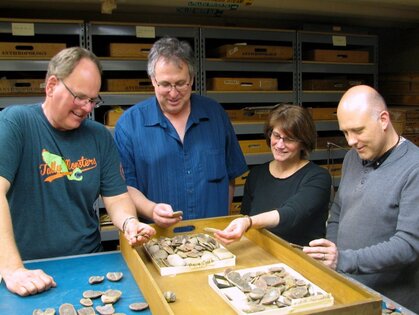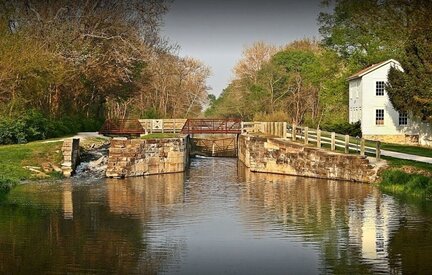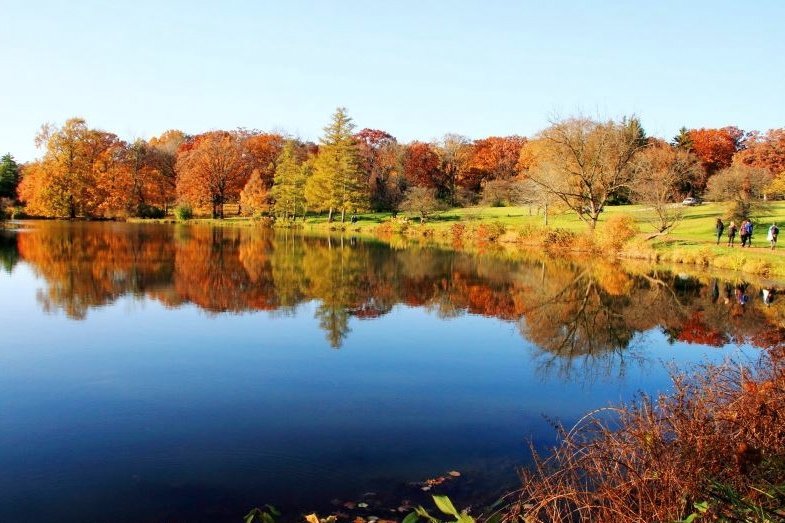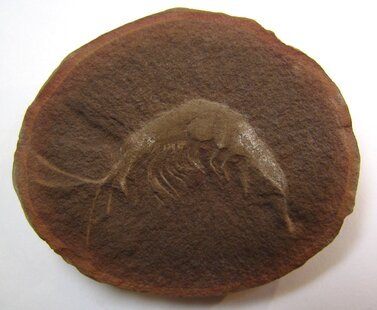Selected Projects
Mazon Creek Fossils
Guest Curator, Geology Collections
Milwaukee Public Museum, Wisconsin, 2016 - present
Chicago Academy of Sciences, 2010 - present
|
In early 2015, I was contacted by the Vertebrate and Invertebrate Collections Manager of the Milwaukee Public Museum, Julia Colby, to consider doing a lecture on “the Mazon Creek fauna and the history of the site and mining there.” Julia and I know one another from when she was working with the collections of the Chicago Academy of Sciences and I was volunteering in its paleontology department. I started with the Chicago institution in 2010 after a behind-the-scenes field trip there had intrigued me, not just because of the depth and diversity of the museum’s holdings, but for the incredible history of the place. Two years prior, I had joined the local Earth Science Club of Northern Illinois (ESCONI), and three years before that began my never-ending obsession with everything Mazon Creek.
|
A late 1800s coal shaft mine spoil near Braceville, Illinois, containing Pennsylvanian Period marine fossils: worms,
bivalves, jellies, crustaceans. |
In other words, by 2015 and the time of my Milwaukee invitation, I was ten years into the research and field-collecting of these fossils, which also included a book project focusing on the animals of the time period. The phenomenon of any fossil record of our prehistoric past is remarkable, but 300-million-year-old Mazon Creek is considered an exceptional site above most others. To announce my lecture topic in Milwaukee, I wrote this:
|
Traversing a coal strip mine spoil at Pit 11, one of the
most famous localities for Mazon Creek fossil animals. A Macroneuropteris scheuchzeri seed fern pinnule from
the Chicago Academy of Sciences collection. |
Coal, Shale, and Ironstone: The Geology & Paleontology of Mazon Creek
Mazon Creek, a designation derived from its namesake tributary of the Illinois River, has formally come to refer to a most incredible fossil array of associated Upper Carboniferous plants and animals. Considered to be among the world’s great Lagerstätten, or Mother Lodes, this site’s numerous and delicately preserved soft-bodied animals are rarely seen in the fossil record, and many species have been singularly described from the deposit. Magnificent plant impressions, many of them ferns (to some, the quintessential prehistoric floral form) are beautifully preserved in iron carbonate nodules. Located in northeastern Illinois, the importance of Mazon Creek to understanding the story of our planet, and specifically the Pennsylvanian Period, was realized by science only in the mid-nineteenth century. Considerable research has been done since then, perhaps providing the most comprehensive picture of life in the Late Paleozoic. Come hear the narrative of its geologic and biological history: how it came to be and what lived there. |
|
Before Milwaukee, most of my work at the Chicago Academy of Sciences had been in collaboration with Joan Bledig, a fellow club member and writing/editing partner on several books, and the Director of Collections, Dawn Roberts. Together, we have processed, cleaned, identified, and cataloged thousands of Mazon Creek specimens, sometimes inviting experts on the subject to join our effort and help resolve the most difficult cases. Founded in 1857, the Chicago Academy of Sciences is one of America’s oldest scientific institutions. Below is a paragraph I wrote on its unique history which I included in an art show catalog from 2013.
|
Joan Bedig and museum President, Deb Lahey, at a 2011 Collections Tour. Joan built the model dragonfly for a
Chicago Academy of Sciences coal forest exhibit in 1964. |
|
Geology Collections at the Milwaukee Public Museum, 2016.
Bruce Lauer, curator Pat Burke, Andrew Young, and Rich Holm. Bruce is president of the Lauer Foundation for Paleontology, Science, and Education.
|
In the late 1850’s, a young Illinois explorer and cataloger working for the Smithsonian Institution named Robert Kennecott established a natural history museum on what was then the western-most edge of developed areas in the U.S. Considered the First Museum of the West, the Chicago Academy of Sciences was founded in 1857 so that nature enthusiasts and amateur scientists alike could house their specimens and share in their scholarship. Kennecott was an avid naturalist, surveying the vast North American landscape and studying its wildlife. After completing a comprehensive field investigation of southern Illinois for the Illinois Central Railroad, he embarked on a series of explorations in the Alaska Territory, discovering many new animal species and enriching the collections of both the Academy and the Smithsonian. Within a decade, the Chicago Academy of Sciences boasted one of the largest and most important collections in the country. In 1865, Kennecott was commissioned to seek an overland route to Europe via Alaska and Siberia for Western Union Telegraph, where he died at the age of 30, presumably of a heart attack. His discoveries, as publicized before the Senate Foreign Relations Committee, contributed to the eventual purchase of Alaska by the United States in 1867. Tragically, most of Kennecott’s notes and specimens from his expeditions were lost in the Great Chicago Fire of 1871, but the museum persevered, rebuilt in Lincoln Park, and thrived into the 20th century to become a primary center for education and regional natural historical studies.
|
|
My lecture at the Milwaukee Public Museum in 2016 was also an introduction to its staff, exhibits, and geology collections. Apparently, the history of the institution is nearly as old as the Chicago’s and the arc of its foundation is very similar. In the 1850s, Milwaukee established a German-English Academy where its students were encouraged to endeavor collecting field trips, bringing back a variety of organic, geological, and archaeological specimens. These finds were stored and, over time, more were donated and accumulated until it became impossible to adequately care for them. (As an aside, I would say this is analogous to my personal experience in the home – the danger of collecting until there is no more space or possibility for organization…) Around the time of the Chicago Academy of Science’s inauguration, the city of Milwaukee had accessioned the collection and was taking steps in establishing a free public museum.
|
Marie Angkuw and Pat Burke organizing a donation of Mazon Creek animal concretions. Every drawer behind them is filled with hundreds of specimens waiting to be cataloged.
|
|
A Tullimonstrum gregarium a.k.a. "Tully Monster" fossil from the
Milwaukee collection. The museum participated in a 2016 Yale research project describing the mysterious animal as a vertebrate. An Elonichthys hypsilepus fish fossil, MPM VP-359230.
|
After the lecture and luncheon event in 2016, several of us were given a tour by Senior Collection Manager and Curator of Geology Collections, Pat Coorough Burke. As if by some act of fate, I learned they had a very large donation of Mazon Creek fossil material – both flora and fauna examples – that was in need of proper identification and cataloging. Several volunteers had made some progress, sorting-wise, on what looked to be several thousands of stones poured into dozens of long wooden trays. In only a few minutes of perusing the lot, I could tell that the mixture contained many beautiful and even rare fossil organisms. My “training” in Chicago seemed to fit hand-in-glove with what was required in Milwaukee and I eagerly asked Pat when we could begin. We did right away, and with every subsequent visit we’ve made exciting progress on the project. Glorious and unusual life forms from 307 million years ago cover every horizontal surface in the lab when we work. Smiles and cheers accompany the finding of every concretion pairing and ID.
|
|
Collecting in the field is in most respects the obvious “discovery” experience, especially as it applies to gathering physical forms from nature. However, I also think that discovery is a mindset relative to what we know, or have seen, compared to something we haven’t yet seen. For me, combing through hundreds of stones amassed in the basement of a museum, inspecting them, and assigning each to a species that maybe I had previously written about or only have known described in a book is itself a kind of revelation. (Incidentally, it is the same with the art studio process.) Because the Golden Age of Mazon Creek collecting – that is, when coal mining was most active and the fossil material most accessible – is decades in the past, examining an unsorted collection from that era of abundance is like transporting myself there. Assisting the Milwaukee Public Museum with cleaning, identifying, and photographing new specimens to join their already massive and valuable fossil collection is in one way participating in the scholarship aspect of museum work. In another way, it is making a personal pathway for learning and discovery that reaches back to my earliest memories of nature and the outdoors. In natural history, as with art, we are simultaneously experiencing the physical and the ephemeral: object gravity and certainty versus the timelessness, mystery, and magic of what is squarely in our senses but just out of view.
|
Bruce Lauer describing a Tully Monster to museum staff.
Bruce, Pat, and Rich, with Paul Mayer, Collections Manager of Fossil Invertebrates at Chicago's Field Museum.
|
Footnotes:
|
Aux Sable Creek Aqueduct, Morris, Illinois, showing Lock 8
and the Locktender's house, circa 1830s. A 136-foot long "bridge" carries the canal over Aux Sable Creek. |
In 2017, I delivered a similar lecture to members and visitors of the Canal Corridor Association. Based in
La Salle, Illinois, it is the coordinating entity for the Illinois & Michigan Canal National Heritage Area which is affiliated with the National Park System. As America’s first National Heritage Area, the CCA is dedicated to education, protecting nature and open spaces, and preserving the history of the region. When the I & M Canal opened in 1848, it made Chicago and northern Illinois a key crossroads for trade and travel across the U.S. Many towns were created as ports along the water route, connecting others to larger population centers and transforming the economy of the Midwest. Coal mining operations cropped up in northeastern Illinois in order to fuel the fast-growing cities which, curiously, also made more fossil-bearing stones of Mazon Creek available to collectors and, henceforth, broadened the study of organisms and paleoecology from the area’s ancient coal forests. |
|
In 2014, through friends in my collecting community, I was invited to sort and identify a cache of fossil concretions at the Morton Arboretum in Lisle, Illinois. Megan Dunning, the Manager of Community Education and Outreach, had discovered some boxes of stones in storage with no labeling. Since the mission of the Morton Arboretum is to assemble and study living trees, shrubs, and plants from around the world and to educate visitors about growing and conserving trees in order to enhance the environment, it made sense to me that they would also have some examples of prehistoric plant life. The Arboretum was established in 1922 by the founder of the Morton Salt Company, covering roughly 1700 acres and now hosting nearly a quarter of a million plants. Apart from the beautification of the landscape, the Arboretum’s emphasis on scientific research as it applies to tree health and conservation seems especially prescient in today’s world.
|
Lake Marmo at the Morton Arboretum, Lisle, Illinois.
"Fall Colors" 2012, Photo by Jyothi Karthik Raja. |
|
A Kallidecthes richarsoni shrimp fossil in the collection of the Milwaukee Public Museum, P360821.
|
With special permission, I've put together a photo gallery of exciting Mazon Creek fossils from the Milwaukee Public Museum collection. The specimens, along with their images, are property of the museum and therefore copyrighted. They are used here purely for educational purposes, and also because I can't help myself from imagining when Midwest America was equatorial and tropical so many millions of years ago. Thank you, plate tectonics.
|
© The above artworks may be protected by copyright. They are posted on this site in accordance with
fair use principles, and are only being used for informational and educational purposes.
fair use principles, and are only being used for informational and educational purposes.
